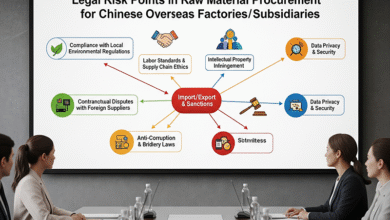

1. Understanding the Unique Procurement Needs of Overseas Cross-Border E-Commerce Buyers
In today’s increasingly globalized business landscape, the rapid development of cross-border e-commerce is undeniable, with the procurement demands of overseas buyers becoming particularly prominent. The distinct nature of these demands sets them apart from traditional B2B trade, meriting a deeper exploration.
Overseas cross-border e-commerce buyers typically seek efficient, convenient procurement processes and flexible transaction methods—a stark contrast to traditional B2B transactions, which rely on complex procedures and face-to-face interactions.
1.1 The Shift Towards Digital Procurement
Firstly, overseas cross-border e-commerce buyers are inclined to leverage digital tools for procurement. This enables them to quickly access product information and make timely decisions, enhancing transaction efficiency while broadening purchasing options.
In traditional B2B trade, buyers often rely on agents or intermediaries—this inadvertently increases time and cost.
1.2 Emphasis on Product Diversity and Personalization
Secondly, overseas buyers’ procurement needs place greater focus on product diversity and personalization. They desire direct communication with suppliers to understand specific product details and explore a vast array of choices, which requires greater supply chain flexibility.
Traditional B2B models often limit buyers to fixed supplier lists, restricting their options.
1.3 The Importance of Information Transparency and Security
Finally, information transparency and security are crucial for overseas cross-border e-commerce buyers. Compared to the high information asymmetry in traditional models, cross-border e-commerce platforms typically offer more open, real-time data analytics—empowering buyers to make informed procurement decisions.
These differences in needs not only influence buyer-seller interactions but also present new challenges to the entire industry chain’s structure and operation.
In the following sections, we will delve deeper into these needs, explore their driving factors, and highlight distinctions from traditional B2B trade.
2. Key Characteristics of Cross-Border E-Commerce Buyer Procurement
As the global market evolves, the procurement demands of overseas cross-border e-commerce buyers are revealing increasingly unique characteristics. These traits reflect current market trends and significantly impact procurement decisions.
2.1 The Rise of Small-Batch Procurement
Firstly, cross-border e-commerce buyers generally lean towards small-batch procurement. Unlike the bulk purchasing in traditional B2B trade, small-batch orders offer flexibility:
- Buyers can better control inventory and mitigate financial risks.
- Businesses can respond rapidly to market changes and cater to diverse consumer needs.
2.2 Multi-Batch Delivery Strategies
Secondly, cross-border e-commerce buyers often use multi-batch procurement. This strategy allows them to:
- Adjust order quantities and product types gradually based on market demand fluctuations.
- Avoid overstocking and financial strain from large, single-purchase orders.
- Test new products and replenish regular stock with dynamic adjustments.
2.3 Growing Demand for Customization and Fast Delivery
Furthermore, customization is a key characteristic. Cross-border e-commerce buyers increasingly prefer suppliers offering customized services—this not only meets unique market demands but also enhances competitiveness.
Additionally, fast delivery is a growing focus. Given rapid market changes, suppliers capable of expedited delivery gain a competitive edge, meeting consumers’ expectations for quick responses.
In summary, small-batch, multi-batch, customization, and fast delivery shape cross-border e-commerce buyers’ procurement strategies, influencing their supply chain management and purchasing decisions.
3. The Traditional B2B Trade Model
Amidst rapid globalization and digitalization, the traditional B2B trade model still holds importance. It primarily emphasizes direct transactions between buyers and sellers, often involving bulk commodities and wholesale business.
Key traits of traditional B2B trade:
- Orders are typically large, and partnerships are long-term.
- Operations involve multiple stages (inquiries → quotations → negotiations → order placement → delivery → after-sales service), requiring significant time.
- A core hallmark is demand for large product volumes—businesses use consolidated purchasing to boost negotiation power and lower unit costs.
However, this model’s limitations are becoming more apparent in the modern market.
3.1 Inflexibility vs. Evolving Market Demands
Firstly, the long-term cooperation model reduces businesses’ agility in responding to market changes. With accelerating shifts in consumer demand, companies struggle to adjust procurement and inventory strategies quickly—leading to tied-up capital and excess inventory.
3.2 Reliance on Traditional Communication
Secondly, traditional B2B trade relies heavily on face-to-face communication and relationship building—this is increasingly ill-suited for today’s transparent, networked society.
Modern buyers expect to access information anytime, anywhere, and conduct autonomous purchases—requiring greater focus on online platforms and digital tools. The rise of cross-border e-commerce also offers broader market options for flexible international trade.
Thus, businesses must consider transitioning to more agile, fast, and efficient operational strategies when re-evaluating traditional procurement models.
4. Advantages of Small-Batch Procurement
In the current global economic environment, small-batch procurement is increasingly a vital strategy for e-commerce sellers. Compared to traditional B2B trade, this flexible method better adapts to market demand fluctuations—reducing inventory pressure, controlling risk, and helping sellers adjust product portfolios.
4.1 Enhanced Flexibility and Market Responsiveness
Firstly, small-batch procurement offers significant flexibility to e-commerce sellers. In a rapidly changing market (where consumer preferences are volatile):
- Sellers can adjust inventory structures promptly to align with trends.
- They can test market reactions to new products, avoiding excessive inventory and reducing financial risks.
4.2 Effective Risk Control and Supplier Diversification
Secondly, small-batch procurement aids in risk control:
- By diversifying purchases, sellers select from multiple suppliers—reducing reliance on any single one.
- Even if a supplier faces production delays, sellers can meet orders through alternative channels.
- It allows better supply chain control, avoiding financial strain from large orders.
4.3 Balancing Costs with Agility
Finally, while small-batch procurement may lack bulk purchasing’s cost advantages, its flexibility and risk control often offset short-term management/operational costs.
As consumer demand for personalization and diversity grows in future e-commerce, small-batch procurement will become even more critical. In short, it helps e-commerce sellers respond to market changes effectively and enhance overall competitiveness.
5. The Growing Trend of Customized Procurement Needs
In recent years, overseas cross-border e-commerce buyers’ procurement demands have shown a clear trend towards customization. This shift reflects the global consumer’s growing desire for personalized products—and with technological advancements and evolving production models, cross-border e-commerce platforms now offer more customized solutions to meet these needs.
5.1 Customization: A Key Differentiator
Compared to traditional B2B trade, overseas cross-border e-commerce buyers’ customization needs are more pronounced. They are no longer satisfied with standardized products; instead, they want to personalize based on individual or market requirements—including product design, functional features, packaging, and additional services.
By offering customization, merchants can attract more customers and boost loyalty/satisfaction.
5.2 Drivers of the Customization Trend
Several factors fuel this trend:
- Social media and online platforms: Make it easier for consumers to discover and express demands for personalized products.
- Global cultural exchange: Leads to diverse consumer aesthetics and needs, driving demand for unique shopping experiences.
- Technological advancements: Make small-batch customization more economically viable, further stimulating personalized development in cross-border e-commerce.
In conclusion, customization demands are not just a market trend—they represent a profound transformation of traditional B2B trade. Merchants must monitor market dynamics and adjust products/services flexibly to meet these needs; those who adapt will gain a competitive edge.
6. The Strategy of Multi-Batch Delivery
Multi-batch delivery refers to dividing an order into multiple shipments during procurement. For cross-border e-commerce (compared to traditional B2B trade), this strategy is crucial—it reflects modern supply chain management’s flexibility and responsiveness, meeting buyers’ immediate needs and delivering goods to markets faster to enhance satisfaction.
6.1 Optimizing Delivery and Inventory
When implementing multi-batch delivery, e-commerce platforms typically plan shipping strategies based on order volume and buyer needs. This approach:
- Shortens customer waiting times.
- Allows timely product adjustments based on market feedback.
For example, during peak sales seasons, phased delivery helps manage inventory effectively—preventing overstocking from slow sales and reducing financial pressure.
6.2 Enhancing Supply Chain Efficiency
Multi-batch delivery significantly boosts supply chain efficiency and responsiveness:
- Merchants can adjust shipping plans quickly based on sales performance and market demand (prioritizing popular items).
- Segmented delivery reduces transportation costs through optimized logistics, minimizing unnecessary expenses.
- Using advanced digital technologies, merchants track each batch’s logistics status in real-time—enhancing supply chain transparency and control.
In essence, this strategy optimizes logistics and provides consumers with a more efficient shopping experience—demonstrating e-commerce businesses’ understanding of customer needs and driving international trade innovation.
7. The Significance of Fast Delivery
In cross-border e-commerce operations, the importance of fast delivery cannot be overstated. Compared to traditional B2B models, buyers increasingly demand quicker delivery times—and cross-border e-commerce offers a more flexible, efficient procurement experience that traditional trade struggles to match.
Fast delivery not only enhances customer satisfaction but also strengthens a company’s market competitiveness.
7.1 Accelerating Market Responsiveness
On one hand, fast delivery shortens the procurement cycle—enabling buyers to respond rapidly to market demands. In today’s digital age, consumer needs change quickly, and cross-border e-commerce’s fast delivery model provides timely products.
Ensuring prompt delivery depends on supply chain optimization: efficient warehousing, logistics, and information flow—all of which must be enhanced through technology.
7.2 Maintaining Quality Alongside Speed
On the other hand, fast delivery does not mean sacrificing product quality. To achieve efficient delivery while maintaining high quality, businesses need:
- Effective production process and quality control measures.
- A robust quality management system and continuous supplier evaluation.
- Collaboration with reliable suppliers to ensure products meet standards during production and transportation.
In conclusion, fast delivery is pivotal in cross-border e-commerce—it impacts the customer experience, company profits, and brand image. By optimizing the supply chain and maintaining quality, cross-border e-commerce can meet user demands and achieve fast delivery goals.
8. The Necessity of Supplier Classification
In today’s fast-evolving cross-border e-commerce sector, buyers face numerous supplier choices. To streamline procurement and improve transaction efficiency, classifying suppliers is paramount.
Through effective classification, cross-border e-commerce buyers can quickly identify suppliers that meet their specific needs—avoiding decision delays from information overload.
8.1 Streamlining the Search for Ideal Suppliers
Firstly, supplier classification enables effective categorization based on criteria like product type, market positioning, geographic location, and business scale. This detailed grouping:
- Helps buyers find suitable products quickly.
- Allows them to understand different suppliers’ strengths and weaknesses for informed decisions.
8.2 Enhancing Information Transparency and Reducing Risk
Secondly, supplier classification promotes information transparency. Within this system, buyers can easily access key supplier details: product quality, delivery times, pricing, and after-sales service.
This not only speeds up procurement decisions but also reduces risks in unfamiliar markets. By analyzing this information, buyers can compare suppliers clearly and select the best partners.
8.3 Boosting Competitiveness and Customer Experience
Finally, supplier classification enhances cross-border e-commerce competitiveness:
- A supplier-centered classification model prompts platforms to provide more accurate product recommendations to buyers, improving user experience.
- Precise matching boosts customer satisfaction, fosters strong buyer-seller relationships, and encourages repeat business.
Thus, understanding and utilizing supplier classification is crucial for cross-border e-commerce buyers.
9. Conclusion and Future Outlook
The unique procurement needs of cross-border e-commerce buyers have triggered significant changes in the global market. Compared to traditional B2B trade, these demands are more diverse and personalized—requiring businesses to innovate continuously to adapt to the complex market environment.
Cross-border e-commerce offers immense advantages in flexibility, speed, and globalization; buyers typically want to access product information quickly and track orders in real-time. This demand for rapid responses drives supply chain and logistics innovation, propelling technological advancements.
9.1 The Impact of Digitalization and Global Reach
Concurrently, cross-border e-commerce’s rise has promoted digital payments and online transactions—enabling seamless global shopping. This shift not only enhances the shopping experience but also compels sellers to focus more on product quality, after-sales service, and brand image.
For businesses, understanding and adapting to these evolving needs will secure their place in a competitive market.
9.2 Key Strategies for Future Success
Looking ahead, as technology advances and markets open further, cross-border e-commerce buyers’ demands will continue to evolve. To remain competitive, businesses need to:
- Establish more flexible supply chains.
- Use data analytics to seize market opportunities promptly.
- Foster strong customer relationships and personalized services to boost loyalty.
In summary, adapting to and meeting the ever-changing needs of cross-border e-commerce buyers will be key to future business success.




